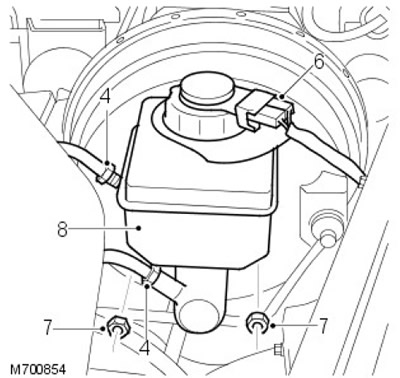Removing
1. Disconnect a wire of weight from the accumulator.
2.
CAUTION: Avoid spilling brake fluid on the paintwork as this may damage the paintwork. If spilled, remove any traces of liquid and rinse the area with clean, warm water.
Place a suitable container under the master cylinder to collect escaping brake fluid.
3. Clean the area around the master cylinder ports.
4. Loosen the two brake line nipple connections on the master cylinder ports.
5. Disconnect both brake lines from the master cylinder. Close, but do not plug, the ends of the pipelines to prevent the ingress of dirt.
6. Release the two connectors on the tank cover.
7. Turn away two nuts of fastening of the main cylinder to the vacuum amplifier of brakes.
8. Disconnect the main cylinder from the vacuum amplifier and remove it.

9. Carefully remove the reservoir from the master cylinder, «unscrewing» it from the seals.
10.
NOTE: The seals between the master cylinder and reservoir are different sizes.
Remove the seals from the master cylinder.
Installation
1. Install NEW seals to the master cylinder, making sure the seals are in the correct ports.
2. Install the reservoir on the master cylinder.
3. Ensure that the water seal is in place and install the master cylinder on the booster.
4. Screw nuts of fastening of the main cylinder to the amplifier and tighten by force of 26 Nanometers.
5. Connect the brake lines to the master cylinder and tighten to 15 Nm.
6. Install two connectors on the tank cover.
7. Fill reservoir with recommended brake fluid.
For more information, please refer to the chapter: Specifications (206-00 Brake system - General information, Specifications).
8. Remove air from the brake system.
For more information, refer to the chapter: Bleeding the brake system (206-00 Brake system - General information, General procedures).
Comments on this article